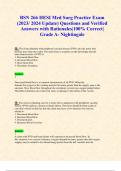Exam (elaborations)
BSN 266 HESI Med Surg Practice Exam Version 1 (2023/ 2024 Update) Questions and Verified Answers with Rationales|100% Correct| Grade A- Nightingale
- Course
- Institution
BSN 266 HESI Med Surg Practice Exam Version 1 (2023/ 2024 Update) Questions and Verified Answers with Rationales|100% Correct| Grade A- Nightingale Q: The client admitted with peripheral vascular disease (PVD) asks the nurse why her legs hurt when she walks. The nurse bases a response on the ...
[Show more]



